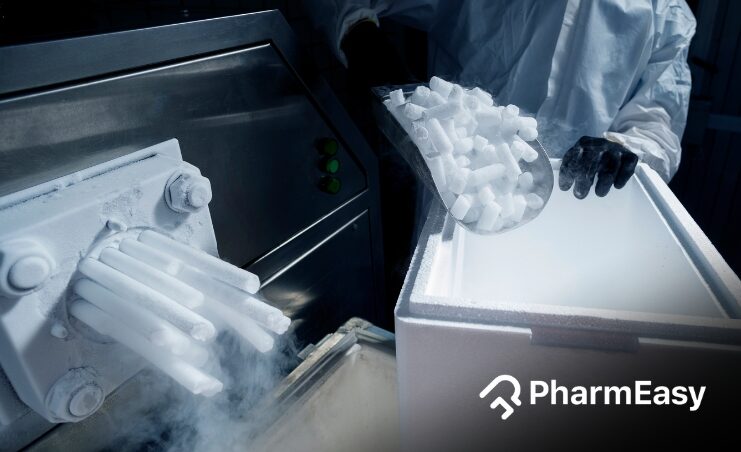Is Dry Ice Dangerous?
By Dr. Nikita Toshi +2 more

Get,

to manage your symptom
Get your,


4 Cr+ families
benefitted

OTP sent to 9988776655



You’ve successfully subscribed to receive
doctor-approved tips on
Whatsapp

Get ready to feel your best.

Hi There,
Download the PharmEasy App now!!


Register to Avail the Offer
Send OTPBy continuing, you agree with our Privacy Policy and Terms and Conditions

Hi There,
Sign up on PharmEasy now!!
Trusted by 4 crore+ families

OTP sent to 9988776655



You have unlocked 25% off on medicines




Code: NU25
By Dr. Nikita Toshi +2 more
Table of Contents
Recently, dry ice has been in the news due to an unfortunate incident that occurred at a cafe in Gurugram, Haryana. Five diners unwittingly consumed dry ice, mistaking it for mouth freshener.

As per news reports, the diners suffered serious injuries to their food pipe and oral cavity after accidentally ingesting the dry ice. This incident has stirred the food industry and consumers across India, highlighting the importance of awareness about dry ice among the masses.
So, in this article, let us understand what is dry ice, why it is dangerous and what can happen if you accidentally ingest it.
Dry ice is opaque, solidified carbon dioxide that forms at temperatures of around -78.5 degrees Celsius or -109.3 degrees Fahrenheit. Carbon dioxide is compressed and cooled from its gaseous to the solid state. Dry ice is typically used to preserve frozen foods during transit. When dry ice comes in contact with warmer temperatures, it sublimes to a gaseous state directly. If mishandled, dry ice can pose serious health hazards to living beings.
Dry ice is extremely cold and can cause frostbite to skin and soft tissues. Therefore, the room where dry ice is stored or handled should be adequately ventilated.
Regular ice and dry ice are quite similar in appearance. However, they differ in the following ways:
Dry ice is a versatile product that can be used across industries. Its main application is acting like a refrigerant, preserving perishable items where mechanical means of freezing are unavailable.
Other uses of dry ice include:
US FDA and FSSAI do not restrict the usage of dry ice in the food industry specifically. Dry ice must be used in ways that keep food safe for consumers. Often, dry ice is used as a coolant to freeze and store food and beverages. It is also popularly used in restaurants to enhance the aesthetics of served food. Caution must be exercised while storing and using dry ice to prevent injuries and asphyxiation. All the while taking extreme care to ensure it doesn’t come in contact with the edibles.
It is recommended that dry ice be used only when mechanical options are not available.
Dry ice should never be consumed directly because it can perforate internal organs. It can also damage the skin if not handled with special gloves.
Although dry ice is sometimes used in food and beverages for visual appeal, you may be asking: Is dry ice edible and is it edible with drinks?
It is not. This is because dry ice maintains very low temperatures. If consumed by accident, it damages internal organs and tissues, corrodes the digestive system and can cause ulceration. If dry ice is ingested, medical help should be sought immediately.
Asphyxiation occurs when the body is deprived of oxygen, leading to suffocation and potentially fatal consequences. This can happen when the air in a confined space becomes depleted of oxygen, usually due to the presence of gases like carbon dioxide or other factors that displace oxygen. This is a medical emergency. Affected person should be moved to a well-ventilated area till help arrives.
Some of the ways in which risks associated with handling dry ice can be minimized are listed below:
For Food Employees specifically,
Thorough knowledge about dry ice and the risks it poses if not properly handled can minimise accidents and threats to those coming in contact with it. If a person does come into direct contact with dry ice or if it is ingested, medical attention should be sought right away.
Disclaimer: The information provided here is for educational/awareness purposes only and is not intended to be a substitute for medical treatment by a healthcare professional and should not be relied upon to diagnose or treat any medical condition. The reader should consult a registered medical practitioner to determine the appropriateness of the information and before consuming any medication. PharmEasy does not provide any guarantee or warranty (express or implied) regarding the accuracy, adequacy, completeness, legality, reliability or usefulness of the information; and disclaims any liability arising thereof.
Links and product recommendations in the information provided here are advertisements of third-party products available on the website. PharmEasy does not make any representation on the accuracy or suitability of such products/services. Advertisements do not influence the editorial decisions or content. The information in this blog is subject to change without notice. The authors and administrators reserve the right to modify, add, or remove content without notification. It is your responsibility to review this disclaimer regularly for any changes.

Leave your comment...
Comments